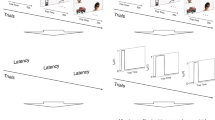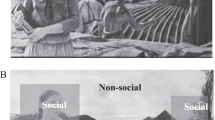Abstract
Individuals with autism spectrum disorder (ASD) tend to experience greater difficulties with social communication and sensory information processing. Of particular interest in ASD biomarker research is the study of visual attention, effectively quantified in eye tracking (ET) experiments. Eye tracking offers a powerful, safe, and feasible platform for gaining insights into attentional processes by measuring moment-by-moment gaze patterns in response to stimuli. Even though recording is done with millisecond granularity, analyses commonly collapse data across trials into variables such as proportion time spent looking at a region of interest (ROI). In addition, looking times in different ROIs are typically analyzed separately. We propose a novel multivariate functional outcome that carries proportion looking time information from multiple regions of interest jointly as a function of trial type, along with a novel constrained multivariate functional principal components analysis procedure to capture the variation in this outcome. The method incorporates the natural constraint that the proportion looking times from the multiple regions of interest must sum up to one. Our approach is motivated by the Activity Monitoring task, a social-attentional assay within the ET battery of the Autism Biomarkers Consortium for Clinical Trials (ABC-CT). Application of our methods to the ABC-CT data yields new insights into dominant modes of variation of proportion looking times from multiple regions of interest for school-age children with ASD and their typically developing (TD) peers, as well as richer analysis of diagnostic group differences in social attention.











Similar content being viewed by others
Data Availiability
The ABC-CT data are publicly available at NIMH NDA (#2288) (https://nda.nih.gov/edit_collection.html?id=2288). The R code and documentation for implementing the CS-MFPCA on simulated datasets are provided on Github at https://github.com/dsenturk/CS-MFPCA.
References
American Psychiatric Association (2013) Diagnostic and statistical manual of mental disorders: DSM-5, vol 10. American Psychiatric Association, Washington, DC
FDA-NIH Biomarker Working Group et al. (2016) BEST (Biomarkers, EndpointS, and other Tools) resource. US FDA, Silver Spring
Carter BT, Luke SG (2020) Best practices in eye tracking research. Int J Psychophysiol 150:49–62
Karatekin C (2007) Eye tracking studies of normative and atypical development. Dev Rev 27(3):283–348
Califf RM (2018) Biomarker definitions and their applications. Exp Biol Med 243(3):213–221
Insel TR (2017) Digital phenotyping: technology for a new science of behavior. J Am Med Assoc 318(13):1215–1216
McPartland JC, Bernier RA, Jeste SS, Dawson G, Nelson CA, Chawarska K et al (2020) The Autism Biomarkers Consortium for Clinical Trials (ABC-CT): scientific context, study design, and progress toward biomarker qualification. Front Integr Neurosci 14:16
Shic F (2016) Eye tracking as a behavioral biomarker for psychiatric conditions: the road ahead. J Am Acad Child Adolesc Psychiatry 4(55):267–268
Webb SJ, Shic F, Murias M, Sugar CA, Naples AJ, Barney E et al (2020) Biomarker acquisition and quality control for multi-site studies: the autism biomarkers consortium for clinical trials. Front Integr Neurosci 13:71
McPartland JC (2020) The autism biomarkers consortium for clinical trials. https://nda.nih.gov/edit_collection.html?id=2288
Ramsay JO, Silverman BW (2005) Functional data analysis. Springer, New York
Horváth L, Kokoszka P (2012) Inference for functional data with applications. Springer Science & Business Media, Berlin
Müller HG (2005) Functional modelling and classification of longitudinal data. Scand J Stat 32(2):223–240
James GM, Hastie TJ, Sugar CA (2000) Principal component models for sparse functional data. Biometrika 87(3):587–602
Rice JA (2004) Functional and longitudinal data analysis: perspectives on smoothing. Stat Sin 14(3):631–647
Şentürk D, Müller HG (2010) Functional varying coefficient models for longitudinal data. J Am Stat Assoc 105(491):1256–1264
Ramsay JO, Silverman BW (2008) Functional data analysis. İnternet Adresi: https://link.springer.com/book/10.1007/b98888
Jacques J, Preda C (2014) Model-based clustering for multivariate functional data. Comput Stat Data Anal 71:92–106
Chiou JM, Chen YT, Yang YF (2014) Multivariate functional principal component analysis: a normalization approach. Stat Sin 24:1571–1596
Happ C, Greven S (2018) Multivariate functional principal component analysis for data observed on different (dimensional) domains. J Am Stat Assoc 113(522):649–659
Shic F, Naples AJ, Barney EC, Chang SA, Li B, McAllister T et al (2022) The autism biomarkers consortium for clinical trials: evaluation of a battery of candidate eye-tracking biomarkers for use in autism clinical trials. Mol Autism 13(1):1–17
Talská Menafoglio A, Machalová J, Hron K, Fiserová E (2018) Compositional regression with functional response. Comput Stat Data Anal 123:66–85
Stefanucci M, Mazzuco S (2022) Analyzing cause-specific mortality trends using compositional functional data analysis. J R Stat Soc Ser A Stat Soc 185(1):61–83
Acknowledgements
We thank the ABC-CT investigators for making this study possible. We thank the staff, patients, and families involved in the ABC-CT study.
Funding
This work was supported by National Institute of Mental Health R01 MH122428 and U19 MH108206.
Author information
Authors and Affiliations
Corresponding author
Ethics declarations
Conflict of interest
McPartland consults with Customer Value Partners, Bridgebio, Determined Health, and BlackThorn Therapeutics, has received research funding from Janssen Research and Development, serves on the Scientific Advisory Boards of Pastorus and Modern Clinics, and receives royalties from Guilford Press, Lambert, Oxford, and Springer. Shic consults for Roche Pharmaceutical Company, Janssen Research and Development, BlackThorn Therapeutics, and BioStream Technologies.
Rights and permissions
Springer Nature or its licensor (e.g. a society or other partner) holds exclusive rights to this article under a publishing agreement with the author(s) or other rightsholder(s); author self-archiving of the accepted manuscript version of this article is solely governed by the terms of such publishing agreement and applicable law.
About this article
Cite this article
Kwan, B., Sugar, C.A., Qian, Q. et al. Constrained Multivariate Functional Principal Components Analysis for Novel Outcomes in Eye-Tracking Experiments. Stat Biosci (2023). https://doi.org/10.1007/s12561-023-09399-1
Received:
Revised:
Accepted:
Published:
DOI: https://doi.org/10.1007/s12561-023-09399-1




